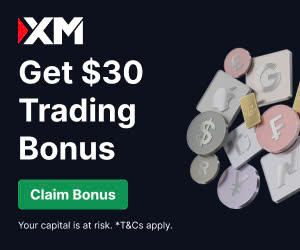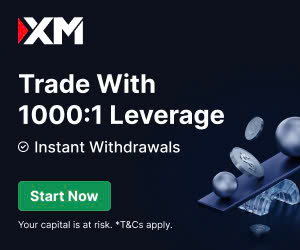
9 minute read
XM vs Coindcx: A Comprehensive Comparison
The financial trading world has evolved rapidly, offering diverse platforms for forex, CFDs, and cryptocurrencies. Two prominent names often compared are XM, a well-established forex and CFD broker, and CoinDCX, India’s leading cryptocurrency exchange. While XM caters to traditional financial markets, CoinDCX focuses on the dynamic crypto space. This article provides an in-depth comparison of XM vs CoinDCX, covering their features, fees, security, user experience, and more, to help you decide which platform suits your trading needs in 2025.

💥 Trade with XM now: Open An Account or Visit Brokers 🏆
1. Introduction to XM vs CoinDCX
XM: A Global Forex and CFD Broker
Founded in 2009, XM Group is a globally recognized broker operating under multiple regulatory bodies, including CySEC (Cyprus), ASIC (Australia), and DFSA (Dubai). XM offers trading in forex, commodities, indices, stocks, and CFDs, catering to both novice and experienced traders. Known for its competitive spreads, low minimum deposits, and robust trading platforms (MetaTrader 4 and 5), XM has built a reputation for reliability and transparency.
CoinDCX: India’s Crypto Powerhouse
Launched in 2018, CoinDCX is India’s largest cryptocurrency exchange, headquartered in Mumbai. It provides a user-friendly platform for trading over 200 cryptocurrencies, including Bitcoin, Ethereum, and altcoins. CoinDCX is ISO-certified and emphasizes security, liquidity, and accessibility, making it a top choice for Indian crypto traders. The platform also offers advanced features like margin trading, futures, and staking.
While XM vs CoinDCX operate in different financial domains, their shared focus on user experience, security, and diverse trading options makes them comparable for traders exploring both traditional and crypto markets.
Primary Keywords: XM vs CoinDCX, forex trading, cryptocurrency exchange, trading platforms 2025
2. Key Features Comparison
XM Features
· Trading Platforms: MetaTrader 4 (MT4) and MetaTrader 5 (MT5), industry-standard platforms with advanced charting, automation, and customization.
· Account Types: Micro, Standard, Ultra-Low, and Shares accounts, catering to different trading styles and capital sizes.
· Leverage: Up to 1:1000 (depending on regulation and account type), allowing amplified trading potential.
· Minimum Deposit: As low as $5 for Micro and Standard accounts, making it beginner-friendly.
· Educational Tools: Webinars, tutorials, and market analysis for traders of all levels.
CoinDCX Features
· Trading Options: Spot, margin, futures, and staking for a wide range of cryptocurrencies.
· Crypto Dashboard: Intuitive interface for tracking portfolios and market trends.
· Low Minimum Investment: Start trading with as little as ₹100 (~$1.20 USD).
· Advanced Trading Tools: Margin trading with up to 20x leverage and futures trading for experienced users.
· Okto App: A DeFi-focused mobile app for seamless crypto trading and investment.
Comparison Insight: XM excels in offering versatile trading platforms for forex and CFDs, while CoinDCX shines in crypto-specific features like staking and DeFi integration. Your choice depends on whether you prioritize traditional markets or cryptocurrencies.
Secondary Keywords: XM trading platforms, CoinDCX crypto features, margin trading, staking crypto
3. Fees and Costs
XM Fees
XM is known for competitive pricing, but fees vary by account type:
· Spreads: Average 1.2 pips for EUR/USD on Standard accounts, with Ultra-Low accounts offering tighter spreads (0.6 pips).
· Commissions: Zero for Standard and Micro accounts; Ultra-Low accounts may incur commissions.
· Inactivity Fee: $10/month after 90 days of inactivity.
· Deposits/Withdrawals: No fees for most methods, though third-party charges may apply.
XM’s fee structure is transparent, with no hidden costs, making it attractive for cost-conscious traders.
CoinDCX Fees
CoinDCX employs a maker-taker fee model:
· Spot Trading: 0.1% for both makers and takers, among the lowest in India.
· Futures Trading: 0.04% maker and 0.06% taker fees.
· Withdrawal Fees: ₹10 or 0.2% of the withdrawal amount (whichever is higher).
· No Deposit Fees: Free crypto and fiat deposits.
While CoinDCX’s trading fees are competitive, withdrawal fees can add up for frequent transactions.
Comparison Insight: XM offers lower costs for forex trading with no commission on most accounts, while CoinDCX’s low trading fees make it cost-effective for crypto traders. However, CoinDCX’s withdrawal fees may impact high-frequency traders.
Secondary Keywords: XM fees, CoinDCX trading fees, low-cost trading, crypto withdrawal fees
4. Security and Regulation
XM Security and Regulation
XM operates under strict regulatory oversight:
· Regulators: CySEC, ASIC, DFSA, and IFSC ensure high transparency and client fund protection.
· Security Measures: Client funds are held in segregated accounts, and the platform uses SSL encryption.
· Investor Compensation: Up to €20,000 under CySEC’s Investor Compensation Fund for eligible clients.
XM’s multi-tier regulation makes it a safe choice for global traders.
CoinDCX Security and Regulation
CoinDCX prioritizes security in the crypto space:
· Compliance: Fully compliant with India’s financial regulations, registered with the Financial Intelligence Unit (FIU).
· Security Protocols: 70% of funds in cold storage, AES-256 encryption, and two-factor authentication (2FA).
· Insurance: Partial insurance coverage for stored assets, though coverage varies by cryptocurrency.
While CoinDCX is secure, the lack of global regulatory oversight (compared to XM) may concern international users.
Comparison Insight: XM’s robust global regulation gives it an edge for traditional trading, while CoinDCX’s focus on crypto-specific security suits Indian crypto enthusiasts. Both platforms prioritize user safety, but XM’s broader regulatory framework offers greater assurance.
Secondary Keywords: XM regulation, CoinDCX security, crypto exchange safety, forex broker regulation
5. User Experience and Interface
XM User Experience
XM’s platforms (MT4/MT5) are renowned for their functionality:
· Ease of Use: Intuitive for experienced traders but may have a learning curve for beginners.
· Customization: Extensive charting tools, indicators, and Expert Advisors (EAs) for automated trading.
· Web and Mobile: Seamless integration across desktop, web, and mobile apps.
CoinDCX User Experience
CoinDCX is designed for accessibility:
· Dashboard: Clean, user-friendly interface with real-time portfolio tracking.
· Beginner-Friendly: Simplified buying/selling process, ideal for crypto novices.
· Mobile App: Highly rated for iOS and Android, offering full trading functionality.
Comparison Insight: CoinDCX’s straightforward interface is better for beginners and crypto traders, while XM’s advanced platforms suit experienced traders comfortable with MT4/MT5.
Secondary Keywords: XM user interface, CoinDCX mobile app, beginner-friendly crypto platform, MT4 trading.

💥 Trade with XM now: Open An Account or Visit Brokers 🏆
6. Trading Instruments
XM Trading Instruments
XM offers over 1,380 instruments:
· Forex: 50+ currency pairs, including majors, minors, and exotics.
· CFDs: Indices, commodities, stocks, and metals.
· No Cryptocurrencies: XM does not offer direct crypto trading, focusing on traditional markets.
CoinDCX Trading Instruments
CoinDCX specializes in cryptocurrencies:
· Cryptos: 200+ coins, including Bitcoin, Ethereum, Ripple, and altcoins.
· Trading Pairs: Supports INR and USDT pairs for flexible trading.
· No Traditional Assets: Limited to crypto markets, with no forex or CFDs.
Comparison Insight: XM is ideal for diversified trading across forex and CFDs, while CoinDCX is the go-to for crypto enthusiasts. Your preference depends on whether you want exposure to traditional or crypto markets.
Secondary Keywords: XM trading instruments, CoinDCX cryptocurrencies, forex vs crypto trading
7. Customer Support
XM Customer Support
· Availability: 24/5 via live chat, email, and phone.
· Languages: Supports over 30 languages, ensuring global accessibility.
· Response Time: Quick and professional, with dedicated account managers for VIP clients.
CoinDCX Customer Support
· Availability: 24/7 via live chat, email, and a comprehensive FAQ section.
· Localized Support: Tailored for Indian users, with prompt responses in English and Hindi.
· Reputation: Positive user reviews for quick query resolution.
Comparison Insight: Both platforms offer reliable support, but CoinDCX’s 24/7 availability gives it a slight edge for crypto traders needing round-the-clock assistance.
Secondary Keywords: XM customer support, CoinDCX live chat, crypto trading support
8. Mobile Trading
XM Mobile Trading
· MT4/MT5 Apps: Available for iOS and Android, offering full trading functionality.
· Features: Real-time quotes, charting, and order execution on the go.
· Performance: Stable and fast, though complex for beginners.
CoinDCX Mobile Trading
· CoinDCX App: Highly rated for iOS and Android, with a 4.2/5 rating on Google Play.
· Okto App: DeFi-focused app for advanced crypto trading.
· User-Friendly: Simplified interface for quick trades and portfolio management.
Comparison Insight: CoinDCX’s mobile apps are more intuitive for beginners, while XM’s apps cater to traders familiar with MT4/MT5.
Secondary Keywords: XM mobile trading, CoinDCX app review, crypto mobile trading
9. Educational Resources
XM Educational Resources
· Webinars: Live sessions on forex trading strategies and market analysis.
· Tutorials: Guides on MT4/MT5 usage and risk management.
· Research: Daily market insights and technical analysis.
CoinDCX Educational Resources
· CoinDCX Academy: Video courses, articles, and guides on crypto trading.
· Blog: Updates on market trends, DeFi, and blockchain technology.
· Community: Active social media presence with trading tips.
Comparison Insight: XM’s resources are tailored for forex and CFD trading, while CoinDCX’s academy is ideal for learning about cryptocurrencies and blockchain.
Secondary Keywords: XM trading education, CoinDCX crypto academy, forex trading tutorials
10. Pros and Cons
XM Pros
· Regulated by top-tier authorities (CySEC, ASIC).
· Low minimum deposit ($5).
· Wide range of trading instruments (1,380+).
· Competitive spreads and no commissions on most accounts.
XM Cons
· No cryptocurrency trading.
· Inactivity fees after 90 days.
· Complex platforms for beginners.
CoinDCX Pros
· Supports 200+ cryptocurrencies.
· Low trading fees (0.1% spot).
· Beginner-friendly interface and mobile app.
· Strong security with cold storage and 2FA.
CoinDCX Cons
· Limited to cryptocurrencies.
· Withdrawal fees can add up.
· Less global regulatory oversight compared to XM.
11. Which Platform Should You Choose?
Choosing between XM vs CoinDCX depends on your trading goals:
· Choose XM if:
· You want to trade forex, CFDs, or traditional assets.
· You value strict global regulation and low minimum deposits.
· You’re comfortable with MT4/MT5 and seek diversified trading options.
· Choose CoinDCX if:
· You’re focused on cryptocurrency trading or DeFi.
· You prefer a beginner-friendly platform with low trading fees.
· You’re based in India or want exposure to INR-based crypto trading.
For traders interested in both markets, you could use XM for forex/CFDs and CoinDCX for crypto, leveraging the strengths of each platform.
12. Conclusion
In the XM vs CoinDCX debate, both platforms excel in their respective domains. XM is a powerhouse for forex and CFD trading, offering global regulation, competitive fees, and a wide range of instruments. CoinDCX, on the other hand, dominates India’s crypto market with its user-friendly interface, low fees, and extensive cryptocurrency offerings. By understanding your trading preferences—whether traditional markets or cryptocurrencies—you can choose the platform that aligns with your goals in 2025.
Ready to start trading? Explore XM for forex and CFDs or CoinDCX for crypto, and take your financial journey to the next level.
💥 Note: To enjoy the benefits of the partner code, such as trading fee rebates, you need to register with XM through this link: Open An Account or Visit Brokers 🏆
Read more:




